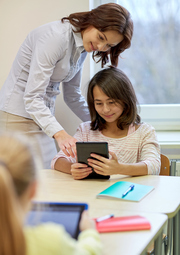How Can Teachers and Parents Leverage the Internet for Children’s Benefit?
Education within a digital world has long been transforming how we teach children, both for teachers in school and parents at home. Still, it is apparent that new challenges will cease for we humans who increasingly rely on technology to better our lives. As the Greek philosopher Heraclitus wrote, “The Only Constant in Life Is Change.”
This idea also includes many positive aspects as unparalleled opportunities and benefits have great potential to enhance the progress of children. With the vast expanse of the internet at their fingertips, teachers and parents hold the power to significantly influence and improve the lives of the young ones they are responsible for.
This post delves into how leveraging the internet can play a pivotal role in children’s welfare, exploring practical strategies for educators and parents alike to navigate this digital domain effectively.
Online Resources for Enhanced Learning
The internet is a treasure trove of educational resources that can significantly enrich the learning experience for children. Many websites now offer free tutorials, interactive games, and comprehensive lesson plans across a wide range of subjects, from math and science to history and geography.
These platforms make learning fun and engaging, allowing children to explore their interests at their own pace.
For parents and teachers, this means being able to provide personalized learning aids that can complement traditional classroom teaching and help address each child’s unique learning needs.
Teachers Advancing Their Education Online
In a commitment to improving children’s lives, teachers can embrace the opportunity to advance their education online, enabling them to take on more specialized roles such as that of a school social worker. Online degree programs and certifications, such as an MSW or Master in Social Work degree, offer flexible schedules that fit the busy lives of working educators.
By gaining additional expertise, such as taking on a school social worker role alongside being an educator, teachers can provide more comprehensive support to their students, addressing not only their academic needs but also their emotional and psychological well-being. This holistic approach to education is crucial for developing well-rounded individuals who are prepared to face life’s challenges.
Parental Guidance in Digital Literacy
Digital literacy is an essential skill in today’s world, and parents play a critical role in guiding their children in becoming responsible digital citizens. It involves teaching them how to use the internet safely and effectively, discerning credible information from misinformation, and understanding the importance of online privacy and security.
By setting a good example and establishing clear guidelines and expectations for internet use, parents can help their children navigate the vast digital world with confidence and caution.
Enhancing Communication through Technology
Technology has revolutionized the way teachers, parents, and students communicate. Digital platforms such as school portals, email, and messaging apps enable instant and convenient updates on school events, homework assignments, and grades. This constant stream of communication fosters a stronger connection between the home and the school, ensuring that parents are up-to-date with their child’s progress and can quickly address any issues that may arise.
Moreover, communication allows for accountability and encourages students to take responsibility for their learning, knowing that their parents and teachers are just a message away.
The Role of EdTech in Personalized Learning
Educational technology (EdTech) has the power to transform learning into a highly personalized experience. With tools that adapt to the learning style and pace of each student, EdTech can identify strengths and weaknesses, tailoring content accordingly to ensure that every child achieves their full potential.
This level of customization is particularly beneficial for students who may need extra help or those who are ready to tackle more challenging material. As a result, children can enjoy a more fulfilling learning journey boosted by technology that meets them where they are.
Internet as a Gateway to Global Perspectives
The internet serves as a window to the world, offering children a chance to learn about cultures, languages, and histories that are vastly different from their own. Websites, virtual tours, and online exchanges can immerse children in global narratives, fostering empathy and broadening their understanding of diversity.
Teachers and parents can guide children through these experiences, encouraging discussions and projects that reflect on these global perspectives. This exposure not only enriches their knowledge but also prepares them to thrive in an interconnected world.
Encouraging Creativity and Innovation
Creativity flourishes when children have the tools to express themselves, and the internet is replete with platforms for artistic exploration. From digital art and music composition to coding and virtual design, the online world is a playground for imaginative minds.
Educators and parents can encourage children to engage with these digital tools, sparking a passion for innovation that could shape their future careers. By supporting children in pursuing these creative outlets, adults help cultivate the next generation of thinkers, artists, and inventors.
Leveraging Online Volunteer Opportunities
The internet offers various volunteer opportunities that children can engage in, fostering a sense of responsibility and community involvement. From virtual tutoring and mentoring to participating in global environmental campaigns, these activities allow children to contribute positively to society.
Teachers and parents can guide children toward reputable organizations and projects where their efforts can make a difference. This not only benefits the causes they support but also enriches the children’s own lives, instilling values of empathy, generosity, and civic engagement.
Collaborative Learning and Projects
The collaborative potential of the internet breaks down geographical barriers, allowing children to work on projects with peers from around the world. This collaboration fosters teamwork, communication skills, and a sense of global citizenship.
Teachers can incorporate online group projects into their curriculum, while parents can encourage participation in international competitions and collaborative platforms. These experiences not only enhance learning but also build valuable life skills.
Access to Mental Health Resources
The internet provides invaluable access to mental health resources, offering support for children dealing with stress, anxiety, and other challenges. Apps, websites, and online counseling services can provide guidance and coping strategies, making mental health support more accessible than ever.
Teachers and parents should guide children toward reputable sources and encourage open conversations about mental well-being. This approach demystifies mental health issues and ensures children know they are not alone in their struggles.
Conclusion
In leveraging the internet’s vast potential, the collective efforts of teachers and parents are crucial in steering children towards experiences that enrich their lives and the lives of others.
These strategies underscore the importance of a balanced approach to the use of technology and the internet, where educational growth, personal well-being, and social responsibility are intertwined.
As we guide the next generation through the digital landscape, our goal should be to cultivate an environment that supports their holistic development, preparing them to thrive in a connected world.








